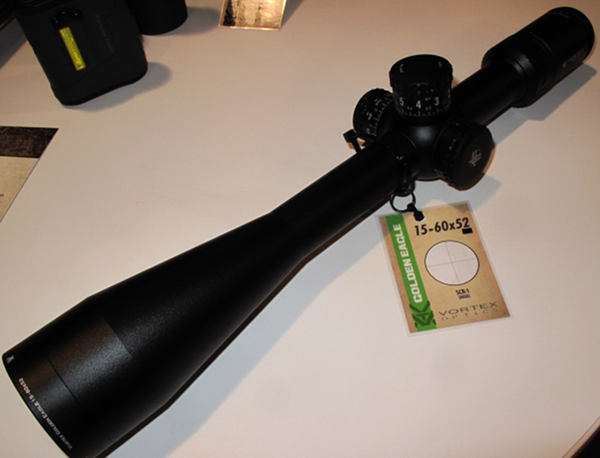SHOT Show Day One: Old Friends, New Products

SHOT Show offers a unique opportunity to see a host of new products AND reconnect with old friends in the shooting world. We met with our friends John Krieger (Krieger Barrels), Ian Kelbly (Kelblys.com), Dave Kiff (PT&G), and Eric Stecker (Berger Bullets). On SHOT Show Day One we saw many interesting items, including a new $1500.00, 15-60x52mm comp scope from Vortex and the amazing Bix’n Andy Elypse action. That 15-60X Vortex should prove a great choice for F-Class competition and the Elypse “raises the bar” for lightweight benchrest actions.
Vortex Optics — “Golden Eagle” 15-60x52mm Competition Scope

Everyone involved in long-range target shooting should check out this New Vortex “Golden Eagle” 15-60x52mm scope. It offers a 4X zoom ratio with 60X max magnification, with an affordable street price of around $1500.00. That undercuts the competition from other major brands by hundreds of dollars. Two reticle options will be offered, a fine cross-hair and one with MOA-based hold-over lines. We’ll provide a more complete report soon….
Howa — Mini-Action Bolt Gun

We finally got our hands on the Mini-action Howa, a very nice little rifle. I immediately noticed that the bolt is extremely smooth — really nice. The HACT 2-stage trigger is excellent — just about perfect for a varmint rifle. The action is nearly an inch shorter than a conventional “short action” so bolt movement is shorter. The rifle is currently offered in .204 Ruger and .223 Remington, and Howa may release a .222 Remington, 6.5 Grendel and 7.62×39 version in the future. Street price on this rifle is around $600.00. I give this rifle two thumbs up, way up. I want one.
Kelbly’s — New Composite GRS Stocks

Kelbly’s is the North American distributor for GRS stocks from Norway. For 2016 GRS has introduced advanced composite stocks. These share the ergonomic design of GRS wood stocks, but offer greater strength, rigidity, and durability. If you are looking for an advanced composite-matrix stock for hunting and tactical applications, you should check out this new GRS. We were very impressed.
Bix’n Andy — Titanium Elypse Action

This may be the most sophisticated benchrest action ever created. The new Bix’n Andy Elypse action will be offered in both stainless and Titanium (shown above). The action features an elliptical profile and a drop port. The trigger, sold separately, is superb, absolutely superb. There are many unique features, such as the flared loading port ramp and easy-change bolt handle. This is truly the Rolls-Royce of precision actions.
Shilen — AR and Savage Drop-in Barrels

We visited the Shilen booth and chatted with Wade Hull, Shilen’s President. Wade explained that Shilen now offers a variety of Drop-in Barrels for Savages as well as “large-format” ARs (AR10 type rifles in 308-family chamberings). Wade also noted that Shilen has streamlined its production process, so wait-time on chambering work has been reduced significantly.
Stocky’s Stocks — New 3D-Printed Prototype Stock

3D Printing and Rapid Prototyping has come to the gunstock world. Stockys Stocks showed off a high-tech 3D-printed prototype of its new tactical stock with removable cheekpiece. We also checked out Stocky’s impressive Long Range composite stocks. Very strong, and very rigid, these stocks feature a CNC-milled aluminum bedding block. These are a stunning value for just $199.99.
RAS Tuners — Combo Tuner + Muzzle Brake

Tuners work — though it may take a bit of time and effort to dial in your tune. The RAS Tuner system combines a sensitive tuner with a removable muzzle brake. There are systems for ARs as well as bolt guns. The inventor of the RAS says he has seen significant reductions in group size.
Tactical Solutions — High-Bling Rimfire Rifles and Pistols

If bling is your thing, then Idaho-based Tactical Solutions has you covered. This company offers a wide variety of firearms including .22 LR rimfire target pistols and rifles. The rifle in this photo is configured with a permanent barrel extension that makes it ATF-compliant. But the actual barrel is threaded below the barrel extension so you can add a suppressor and still have a short overall-length “fun gun”.
Hygenall — LeadOff Products

Anyone who does a lot of shooting may be exposed to lead residues. Lead is a tough substance to remove from human skin. We chatted with the scientists who created these LeadOff products and were quite impressed. The product uses sophisticated chemistry to “grab and remove” the lead molecules on your skin. This product has earned health agency certifications.
Champion — Plinking Targets for Fun Shooting

Among all the “Operator-ready” Black Rifles and Tactical gear, it was nice to see a display dedicated to the simple fun of shooting. As kids, we all started our shooting careers plinking with a BB Gun or a simple rimfire rifle. Champion makes a variety of reactive targets that are great for plinking.
















 CONCLUSION: Stainless steel barrels and components won’t rust nearly as fast as blued steel, but you still have to take precautions — particularly removing sweat and corrosive salts from the barrel. Also, don’t let moisture build up inside or outside of the barrel. We recommend wiping your barrels and actions with Eezox, or Corrosion-X after each use. These are both extremely effective rust-fighters that go on thin, without leaving a greasy residue. (Eezox leaves a clear finish, while Corrosion-X has a slightly waxy finish.) Also store your guns in
CONCLUSION: Stainless steel barrels and components won’t rust nearly as fast as blued steel, but you still have to take precautions — particularly removing sweat and corrosive salts from the barrel. Also, don’t let moisture build up inside or outside of the barrel. We recommend wiping your barrels and actions with Eezox, or Corrosion-X after each use. These are both extremely effective rust-fighters that go on thin, without leaving a greasy residue. (Eezox leaves a clear finish, while Corrosion-X has a slightly waxy finish.) Also store your guns in 




